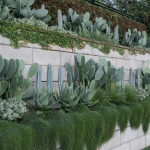Are you looking for creative wall gardens ideas to enhance your interior or exterior space? Wall gardens, also known as vertical gardens or living walls, have become increasingly popular in modern design for their ability to add greenery and beauty to any setting while maximizing limited space. In this article, we will explore the concept of wall gardens, including their benefits, types, plant selection tips, design inspiration, maintenance and care, DIY options, and considerations for both indoor and outdoor settings.
As urbanization continues to grow and green spaces become scarce, wall gardens offer a practical solution for bringing nature into our homes and urban environments. Not only do they provide visual appeal but they also contribute to better air quality by absorbing pollutants. Additionally, wall gardens serve as a unique and innovative way to maximize available space for gardening purposes.
In the following sections of this article, we will delve deeper into the numerous advantages of wall gardens and discuss the different types available. From there, we will provide guidance on how to choose the right plants for your wall garden based on various factors such as light exposure and maintenance requirements.
Lastly, we will present inspiring design ideas from around the world as well as practical tips for maintenance and care of wall gardens. So whether you are looking to create your own DIY wall garden or simply seeking inspiration for your next project, continue reading our comprehensive guide on wall gardens ideas.
Benefits of Wall Gardens
Wall gardens, also known as vertical gardens or living walls, have become increasingly popular in both interior and exterior design due to their unique benefits. One of the most significant advantages of wall gardens is their ability to improve air quality. The plants used in these gardens help to purify the air by removing harmful toxins and pollutants, creating a healthier environment for those around them.
In addition to their environmental benefits, wall gardens also provide aesthetic appeal. Whether it’s a colorful array of flowers or a lush display of greenery, these vertical arrangements add visual interest and beauty to any space. They can serve as stunning focal points or complement existing decor, making them an attractive option for homeowners and businesses alike.
Another key benefit of wall gardens is their space-saving capabilities. In urban environments where outdoor space may be limited, wall gardens offer a practical solution for adding greenery without taking up valuable square footage. They are also ideal for small balconies, patios, and indoor areas where traditional gardening may not be feasible.
When considering wall gardens ideas, it’s important to take into account these various benefits and how they can positively impact your home or business. From improving air quality to enhancing the overall aesthetic appeal and saving space, the advantages of incorporating wall gardens into your design are plentiful. Whether you choose to create a DIY wall garden or invest in professionally designed living walls, the positive impact on your environment and well-being cannot be overstated.
Types of Wall Gardens
Vertical gardens, living walls, and DIY options are all popular choices for creating stunning wall gardens. Each type offers its own unique benefits and considerations, making it essential to understand the differences before deciding on the best option for your space.
Vertical gardens are a popular choice for those looking to maximize their use of vertical space. These gardens typically feature plants arranged in a vertical pattern, either on a specially designed structure or against a wall. They can vary in size and complexity, making them suitable for both indoor and outdoor settings. Some popular plant choices for vertical gardens include succulents, herbs, and small flowering plants.
Living walls take vertical gardening to the next level by incorporating a larger selection of plants and creating a more immersive experience. These installations often include a variety of foliage, flowers, and even edibles. Living walls require proper irrigation systems to ensure the health of the plants, as well as regular maintenance to keep them thriving.
For those who prefer a hands-on approach, DIY wall garden options provide an opportunity to get creative while designing and building a personalized green space. This approach allows for complete customization of plant selection, layout, and materials used. Popular DIY wall garden ideas include repurposing pallets or wooden crates as vertical planters, creating hanging plant displays with macramé or other craft techniques, or using mounted shelves to create staggered planting arrangements.
When selecting the right type of wall garden for your space, consider factors such as available light, desired maintenance level, and overall aesthetic goals. Whether you opt for a ready-made vertical garden system, invest in a lush living wall installation, or embark on a DIY project from scratch, there are endless possibilities for bringing greenery into your home or outdoor area with wall gardens ideas.
Choosing the Right Plants
When it comes to choosing the right plants for your wall garden, there are several factors to consider in order to ensure the success and longevity of your greenery. One of the most important considerations is the amount of light available in the location where your wall garden will be situated. Some plants thrive in full sun, while others prefer shaded areas, so it’s crucial to match your plant selection with the specific lighting conditions of your wall garden.
In addition to light requirements, you’ll also need to assess the available space for your wall garden. If you’re working with a small vertical surface, you may want to opt for compact, low-growing plants that won’t overwhelm the area. On the other hand, if you have a larger expanse to work with, you can consider a greater variety of plant sizes and shapes.
Another key consideration when selecting plants for your wall garden is maintenance requirements. Some plants are more high-maintenance than others, requiring frequent watering, pruning, or fertilizing. If you have a busy schedule or limited gardening experience, it’s wise to choose low-maintenance plants that can thrive with minimal intervention.
It’s also worth considering the overall aesthetic and design concept of your wall garden when choosing plants. Think about color schemes, texture variations, and seasonal interest to create a visually appealing and dynamic display on your vertical canvas. By carefully selecting the right plants based on these factors, you can enjoy a thriving and beautiful wall garden that enhances any indoor or outdoor space.
| Factors Considered | Considerations |
|---|---|
| Light Requirements | Match plant selection with specific lighting conditions |
| Space Availability | Choose compact plants for small areas; more variety for larger spaces |
| Maintenance Requirements | Select low-maintenance plants for busy schedules or limited gardening experience |
| Aesthetic and Design Concept | Consider color schemes, texture variations, and seasonal interest for visual appeal |
By creating a well-thought-out plan for your wall garden and carefully selecting plant varieties based on important factors such as light exposure, space availability, maintenance needs, and design aesthetics; you can ensure that your greenery thrives and enhances its surroundings effectively.
Design Inspiration
When it comes to wall gardens ideas, the possibilities are truly endless. Design inspiration for wall gardens can come from a variety of sources, from architectural masterpieces to simple yet elegant designs.
One stunning example of a creative and unique wall garden is the CaixaForum Madrid in Spain, which features a vertical garden designed by French botanist Patrick Blanc. This living wall is an extraordinary example of how vegetation can be integrated into urban architecture, providing both aesthetic and environmental benefits.
Another inspiring example of a wall garden design is the One Central Park in Sydney, Australia. Designed by architect Jean Nouvel, this residential complex boasts two striking vertical gardens that cover the building’s façade with lush greenery. The use of innovative irrigation systems and carefully selected plant species has resulted in a breathtaking visual display that enhances the overall living experience for residents.
For those looking for DIY wall gardens ideas, there are also plenty of creative and budget-friendly options available. One popular approach is to repurpose old wooden pallets into vertical planters, creating a rustic yet charming addition to any outdoor or indoor space. Another idea is to use repurposed mason jars or hanging pots to create a cascading effect on a blank wall, adding a touch of whimsy and personality to the design.
Overall, these examples show that there are countless ways to incorporate wall gardens into various settings, whether it’s through grand architectural projects or simple DIY solutions. By drawing inspiration from these stunning designs, anyone can find the perfect idea for their own unique wall garden project and bring a touch of natural beauty into their surroundings.
Maintenance and Care
Watering
One of the most crucial aspects of maintaining a healthy wall garden is ensuring that the plants receive an adequate amount of water. Since wall gardens typically have limited soil volume, they can dry out quickly, especially in warmer climates or heated indoor environments.
It’s important to monitor the moisture level of the soil and water as needed, but be careful not to overwater, which can lead to root rot. Consider installing an automated irrigation system for larger wall gardens to ensure consistent and efficient watering.
Fertilizing
Just like any other garden, wall gardens require regular fertilization to provide essential nutrients for plant growth. When selecting a fertilizer, it’s essential to choose one that is suitable for the types of plants in your wall garden and follow the manufacturer’s guidelines for application. Depending on the specific needs of your plants, fertilize them every few weeks during the growing season. Additionally, consider using organic fertilizers to promote the overall health and sustainability of your wall garden.
Pruning
Proper pruning is critical for maintaining the aesthetic appeal and vitality of your wall garden. Regularly trim back overgrown or withered foliage to encourage new growth and prevent overcrowding. This will also help maintain airflow and reduce the risk of pest infestations or disease.
Take care to use sharp, clean tools when pruning and remove any dead or yellowing leaves promptly. By incorporating regular watering, fertilization, and pruning into your maintenance routine, you can ensure that your wall garden thrives year-round.
DIY Wall Gardens
Are you considering adding a touch of green to your space with your very own wall garden? Creating a DIY wall garden is a fun and rewarding project that allows you to showcase your creativity while benefiting from the beauty and freshness of live plants.
Whether you have limited outdoor space or simply want to bring nature indoors, wall gardens are a versatile and unique way to incorporate greenery into your environment. Here’s a step-by-step guide on how to create your own wall garden, along with recommended materials, tools, and easy-to-follow instructions.
Materials and Tools:
- Wooden pallet or vertical planter
- Landscape fabric
- Potting soil
- Succulent plants or small foliage plants
- Hammer and nails or drill and screws
- Staple gun
Instructions:
- Choose the location for your wall garden, whether it’s an outdoor area with sunlight exposure or an indoor space with adequate lighting.
- Prepare the wooden pallet or vertical planter by lining the back with landscape fabric to prevent soil from spilling out.
- Fill the planter with potting soil, ensuring that it’s evenly distributed and level throughout.
- Select succulent plants or small foliage plants that are suitable for vertical gardening and arrange them in the planter based on your design preference.
- Secure the plants in place by using a staple gun to attach the landscape fabric over the roots.
By following these simple steps, you can bring your own DIY wall garden ideas to life while transforming any space into a vibrant oasis of greenery. The key is to select the right materials, choose appropriate plants, and carefully follow the instructions to ensure long-lasting success for your wall garden project.
Whether you’re looking to enhance an outdoor area with a vertical garden or create an eye-catching living wall indoors, DIY wall gardens offer endless possibilities for expressing your personal style and nurturing nature within your surroundings.
Outdoor vs Indoor Wall Gardens
When it comes to creating a wall garden, whether for outdoor or indoor spaces, there are key differences and considerations to keep in mind. Outdoor wall gardens have the advantage of natural sunlight and rainwater, providing an ideal environment for many plant species. However, they also face challenges such as exposure to harsh weather conditions and potential pest infestations.
On the other hand, indoor wall gardens offer more control over environmental factors such as temperature and humidity, allowing for a wider range of plant options. However, they require artificial light sources and regular maintenance to thrive. Understanding these differences is crucial when planning your wall garden project.
Choosing the right plants is essential for both outdoor and indoor wall gardens. For outdoor spaces, consider native plants that are well-suited to your climate and can withstand varying weather conditions. In contrast, indoor wall gardens may require low-light or high-humidity plants depending on the specific conditions of your home or office environment.
Additionally, maintenance routines will differ between outdoor and indoor wall gardens. While outdoor gardens may require occasional pruning and protection from pests, indoor gardens will need regular watering, fertilizing, and monitoring for signs of disease. Both settings present unique opportunities for creative design and personalized expression.
| Plant Considerations | Maintenance Routines |
|---|---|
| Outdoor: Native plants suited to climate | Outdoor: Pruning and pest protection |
| Indoor: Low-light or high-humidity plants |
By carefully considering these differences and factors related to outdoor versus indoor wall gardens, you can create a thriving vertical oasis in any space. Whether you’re looking to enhance an exterior facade or bring nature indoors, the possibilities for innovative wall garden ideas are endless.
Conclusion
In conclusion, wall gardens are a fantastic addition to any space, be it indoors or outdoors. They offer a range of benefits, from improving air quality to enhancing the aesthetic appeal of an environment. With the wide variety of plant options available, there are endless possibilities for creating unique and eye-catching wall gardens.
When considering your own wall garden project, it’s important to carefully select the right plants based on factors such as light and space availability, as well as maintenance requirements. Additionally, drawing inspiration from stunning examples of wall gardens around the world can help spark your creativity and guide your design choices.
Whether you choose to create a DIY wall garden or seek professional installation for a living wall, the satisfaction of nurturing and maintaining your own green oasis is rewarding. So, if you’ve been inspired by the ideas presented in this article, it’s time to start planning and creating your very own wall garden.
Whether it’s a small herb garden in your kitchen or an elaborate living wall in your office lobby, there’s no limit to what you can achieve with some creativity and greenery.
Frequently Asked Questions
How Do I Make a Wall Garden?
Making a wall garden involves choosing a suitable wall, installing a frame or structure for the plants to grow on, selecting the right plants for vertical growth, and ensuring proper irrigation and maintenance.
How Can I Make My Vertical Garden Cheap?
Creating a cheap vertical garden can be done by using inexpensive materials such as PVC pipes, wooden pallets, or even repurposed containers. Growing plants from seeds or cuttings can also save on cost.
What Plants Are Good for Vertical Gardens?
When it comes to choosing plants for vertical gardens, consider those that are lightweight, have shallow root systems, and can thrive in a confined space. Some good options include succulents, ferns, herbs, and small flowering plants like petunias and pansies.

Welcome to my gardening blog! I am passionate about plants and enjoy sharing my knowledge and experiences with others. In this blog, I will write about everything related to gardening, from tips on how to get started to updates on my own garden projects.





